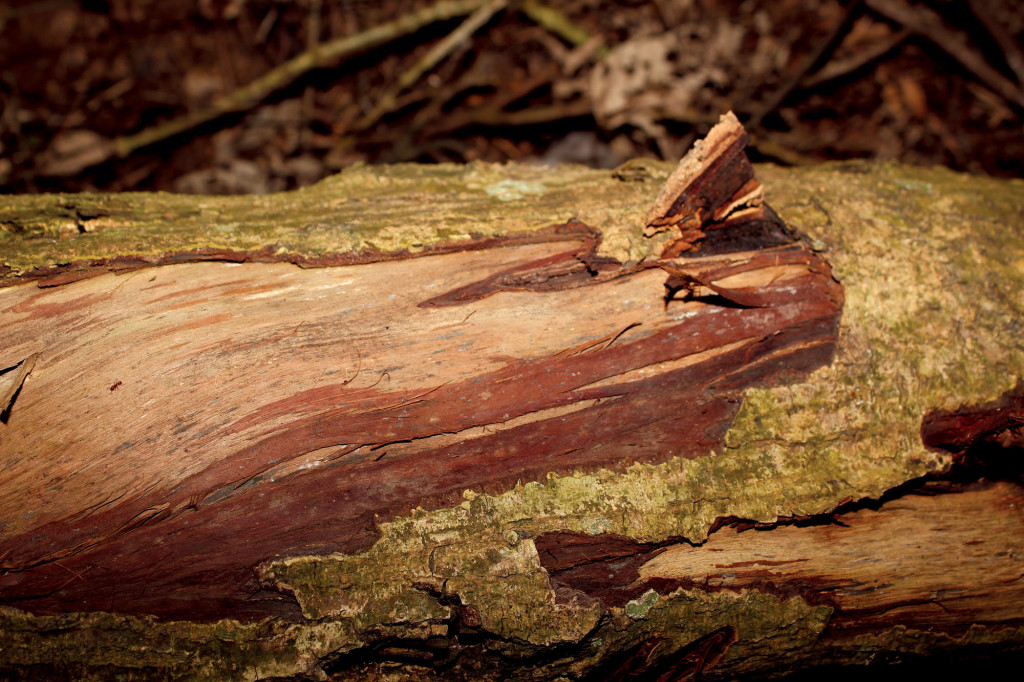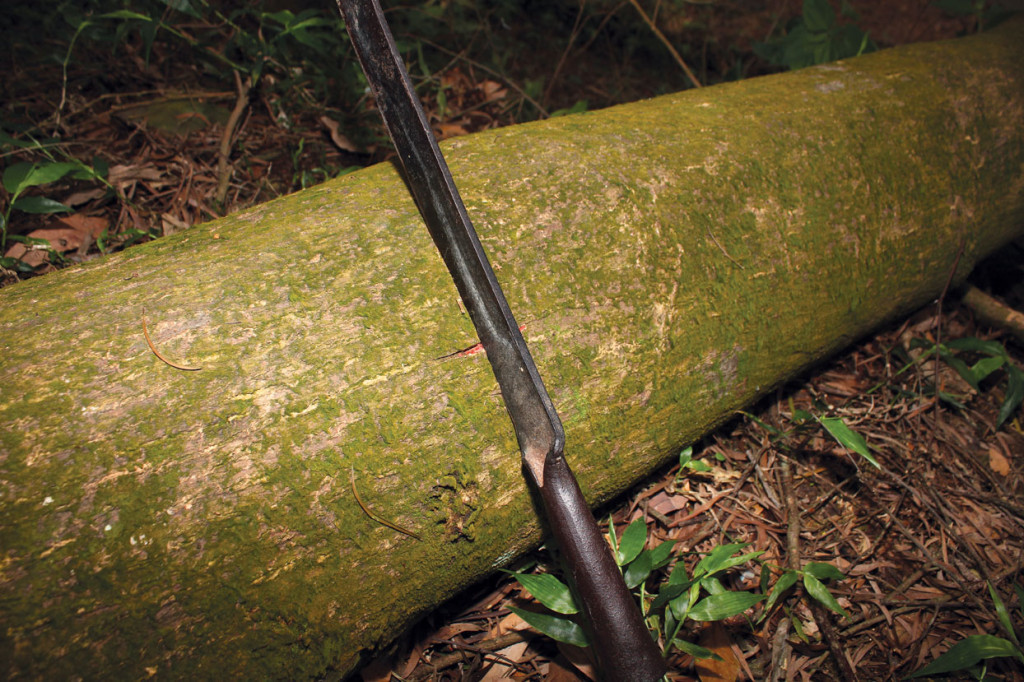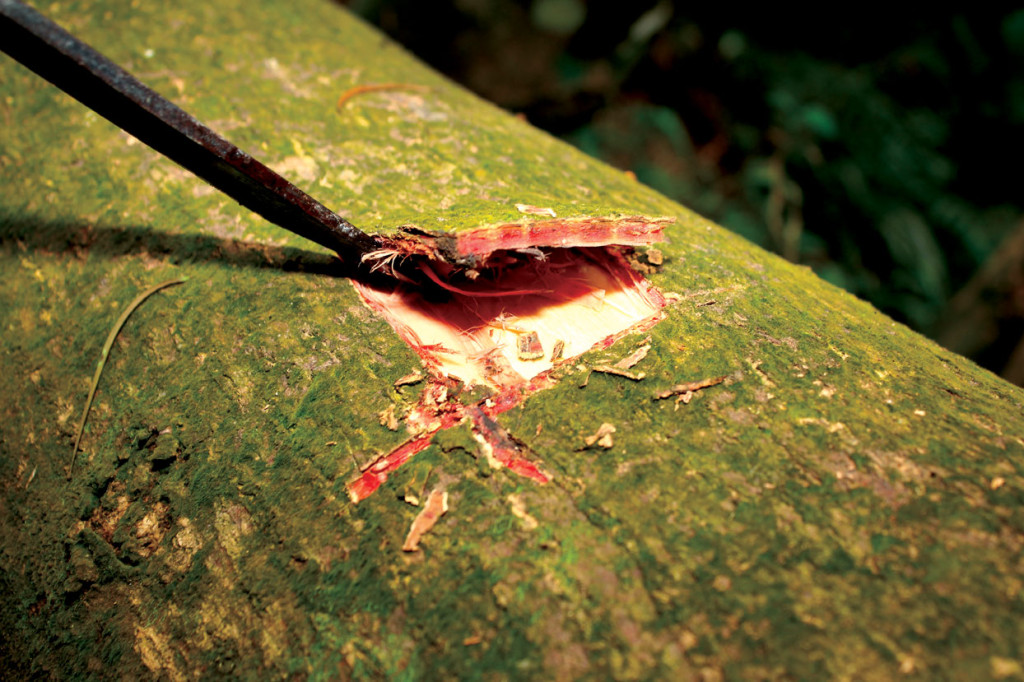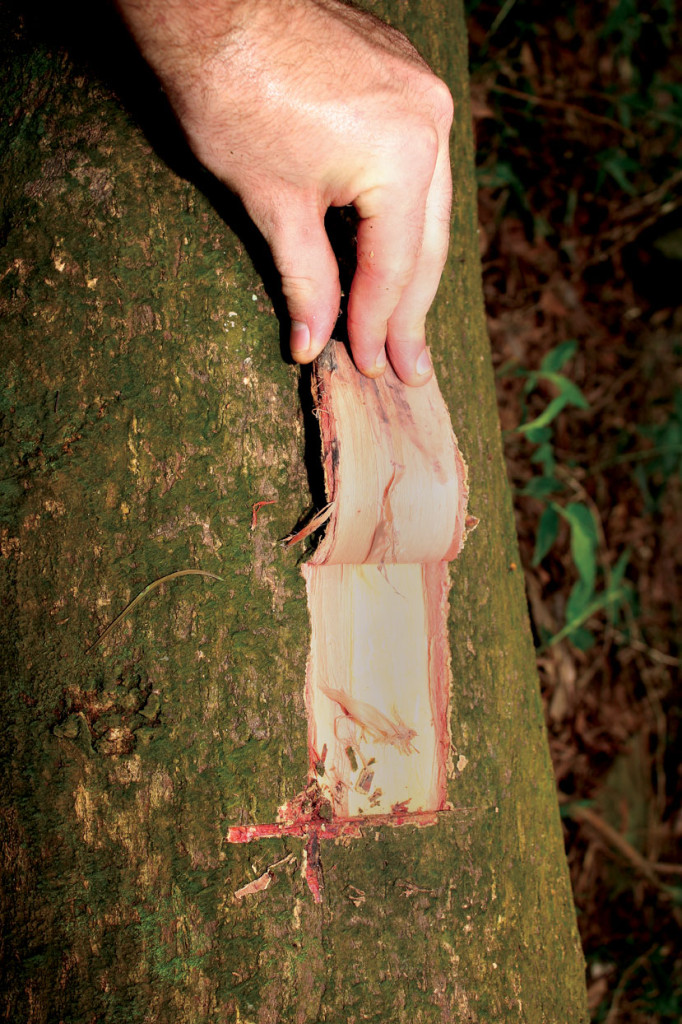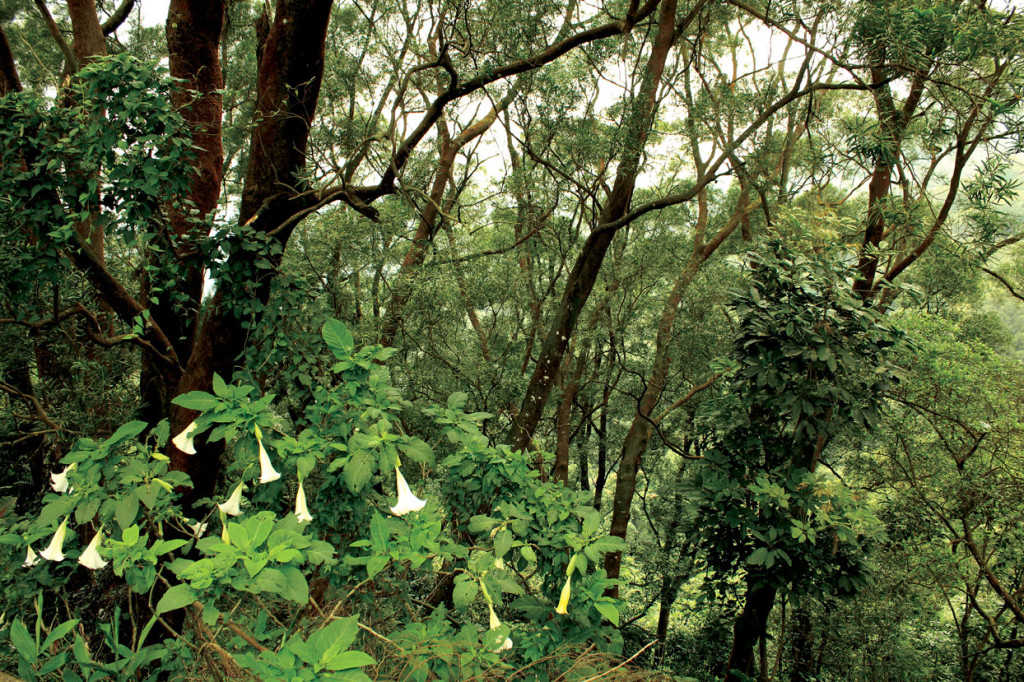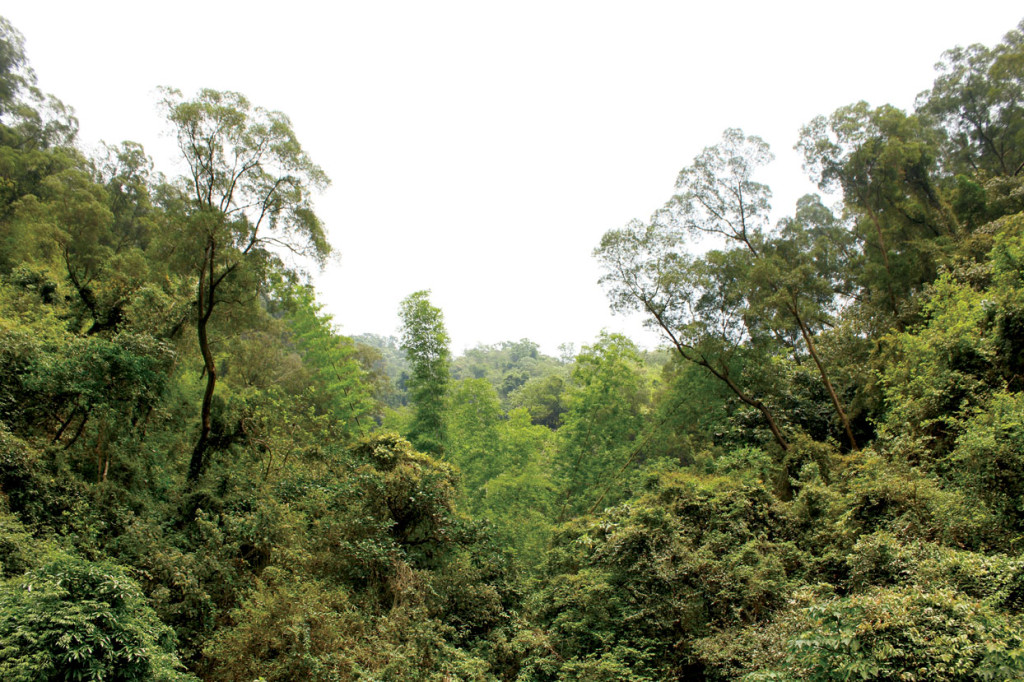Acacia confusa of Taiwan
An important low mountain tree suitable for sustainable ayahuasca use in Asia
Words and Photos by Kada
Taiwan, previously named Formosa, is a small, yet bustling, island nation 394km long, laying smack dab on top of the Tropic of Capricorn. The south of Taiwan is tropical, at low elevations, with distinct dry/wet seasons. However, the north of Taiwan is sub-tropical and may rain throughout the year. From the tropical coastlines, with coral sand beaches and coral rock forests, to the soaring mountains reaching near 4000m bringing snow in winter, this island has an incredible diversity in both ecosystems and the flora that dominates them. Of the 4,200 plus plant species in Taiwan, 1,041 are endemic (Hsieh, C. F., 2002). Despite Taiwan’s high plant diversity and incredibly high plant endemism (26%), the island only has two native Acacia species; however, other species have become naturalized: Acacia confusa and A. caesia (Flora of Taiwan, 1993). This article focuses on Acacia confusa in Taiwan and spiritual and commercial prospects as both an ayahuasca ingredient and as a rich source of tannins.
In Taiwan, Acacia confusa mostly grows today on mountain slopes from 5 to 2,000 meters. Prior to massive human development, Acacia confusa probably spread through the western plain to the coast. However, reproduction continues in restricted localities that have not been paved such as southern Pingtung County. With incredibly strong roots penetrating deep into the shale-like rock, this tree is able to withstand flash floods eroding the soil and winds up to 280KMh. Acacia confusa trees in southern Taiwan can be found up to 2400m, where temperatures may briefly reach 2-3˚ Celsius at night; however, they tend to be more common below 1,500m. Northern localities tend not to grow so high due to colder air temperatures. The distribution range in Taiwan is mostly dictated by both human development and cold temperatures in high mountains. Acacia confusa can be found along the coast, slightly in from the high tide mark; up to the temperate forests of the higher mountains, but well below the freeze line. Acacia confusa is a very adaptable tree suited to living in extreme conditions on a very extreme island.
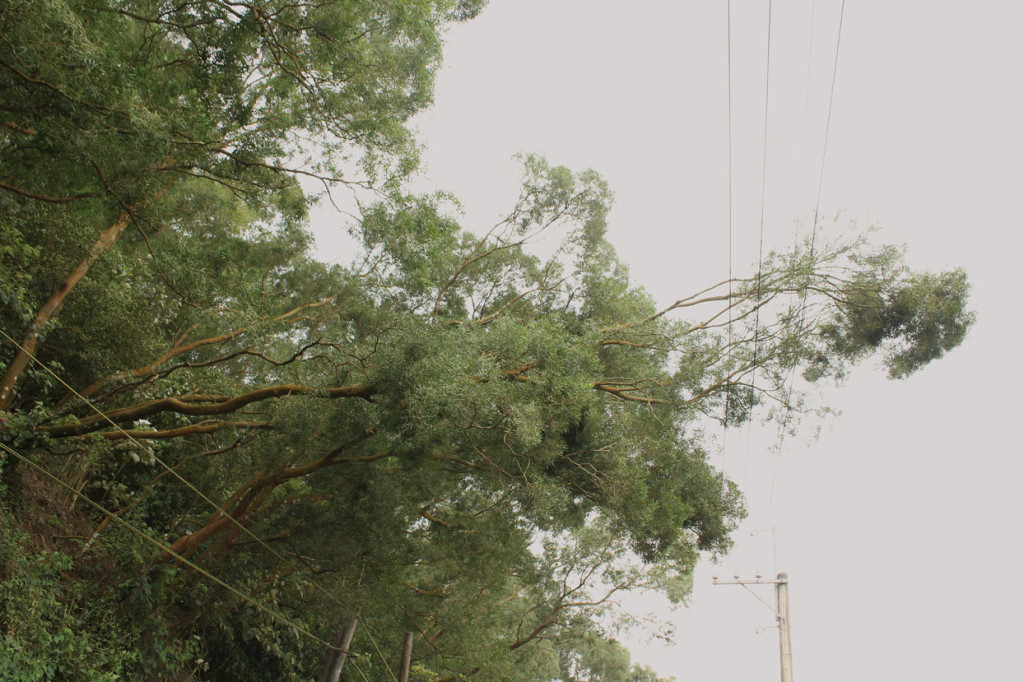
Many times trees will blow over and continue to grow. Here we see trees growing at a 90 degree angle to mountain and hanging over a road. Trees can grow many years in this fashion. Due to dangers for roadways, trees like this are often cut, which provides easy access to bark.
A typical Acacia dominant forest in the mountains of Taiwan consists of about 20-70% Acacia confusa of all tree species (personal observation). In southern Taiwan, where the winter months can be totally without rain, an Acacia forest appears quite dry and brown in the underbrush. Indeed, when hiking though the low to mid-elevation mountains in winter, there is a lovely crackling sound as you glide through the forest floor. Silence is lost as long as you are in motion under an Acacia confusa canopy.
The forest floor is generally either near solid rock, broken rock/gravel caused by landslides, earthquakes or heavy rain, or a very hard clay-based soil of anywhere from a few centimeters to a few meters deep. As a young plant, Acacia confusa generally cannot survive the barren rock type landscapes one may see after heavy rains or earthquakes. Larger trees, on the other hand, are quite well suited to remain on bare mountainsides after having the soil eroded because of a large root systems going deep into the rock. Much of southern Taiwan experiences approximately 1/3 of the year without rain, another 1/3 with very heavy rain, and the other 1/3 with moderate rain. This tree is able to withstand and grow seemingly quite comfortably in a range of places and climates. However, truly dry land is not suitable nor is the cold. One thing that does seem consistent in their habitat in Taiwan is the areas they grow tend not to flood and accumulate water for prolonged periods; however, at the same time the soil underground rarely dries out fully despite the dry appearance on the surface.
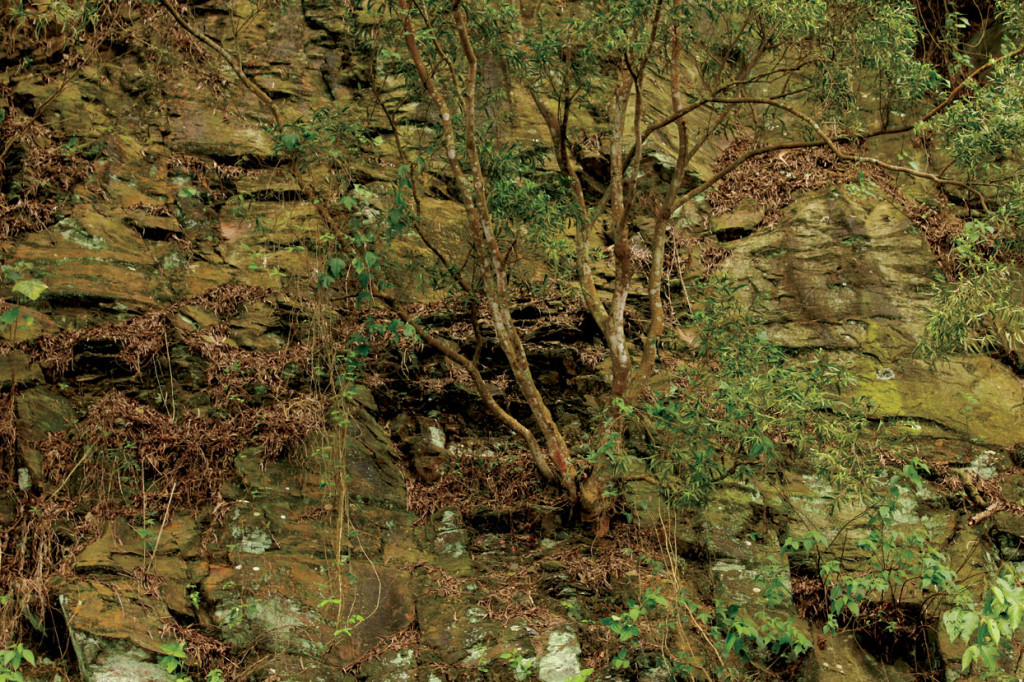
Acacia confusa growing on rocky ground on the side of a mountain. Very few other species of tree are able to do this with good success in Taiwan.
The stems of Acacia confusa are like the roots; incredibly strong. The wood is quite hard and very resilient to high winds. Living in the mountains on an island in direct typhoon paths each summer, these trees have adapted to severe conditions that ultimately made them a very strong tree that now dominates much of the nation. Despite how tough this tree seems, many do not reach truly old ages. Because of where they tend to grow in the mountains, trees are often killed at some point due to landslides and/or extreme winds uprooting and exposing the roots to the sun; an often fatal event. Earthquakes will also shake the mountains enough to cause the rocks to become loose. In addition, sometimes the agitation will cause a top heavy tree to fall to the valley below. Eventually the tree is washed down river for anxious Taiwanese woodworkers to collect for future projects.
Acacia confusa’s Role in Agriculture
Today, many small traditional aboriginal villages remain scattered throughout Taiwan’s central mountain range. Many of these people are hunters and/or farmers. Taiwanese people will use Acacia confusa as a shade tree, sometimes exclusively over other tree species, for its ideal light penetration through the canopy. Under these Acacia canopies, other tree species and all the underbrush will be cleared and the land prepared for the desired crop. In most cases, such cleared land will be planted with either coffee (Coffea arabica) or birds nest fern (Asplenium nidus). The new growth of Asplenium nidus is a common vegetable in Taiwan and has gained so much popularity. Asplenium nidus can be found packaged in major supermarkets around the island. This type of agriculture will sustain these people through the generations without much risk of loss of land quality. In contrast, compare this to the lowlands of Taiwan which have been polluted with over a century of manufacture and unsustainable agriculture practices. One perfect example of poor land management in the mountains of Taiwan included the farming of the betel nut palm (Areca catechu). Entire slopes are cleared and weak rooted palms are planted causing an incredibly high occurrence of landslide and general soil erosion. Not only do Acacia trees provide ideal light conditions for the coffee and fern crops, but they also help keep the mountainsides stable in times of intense weather.
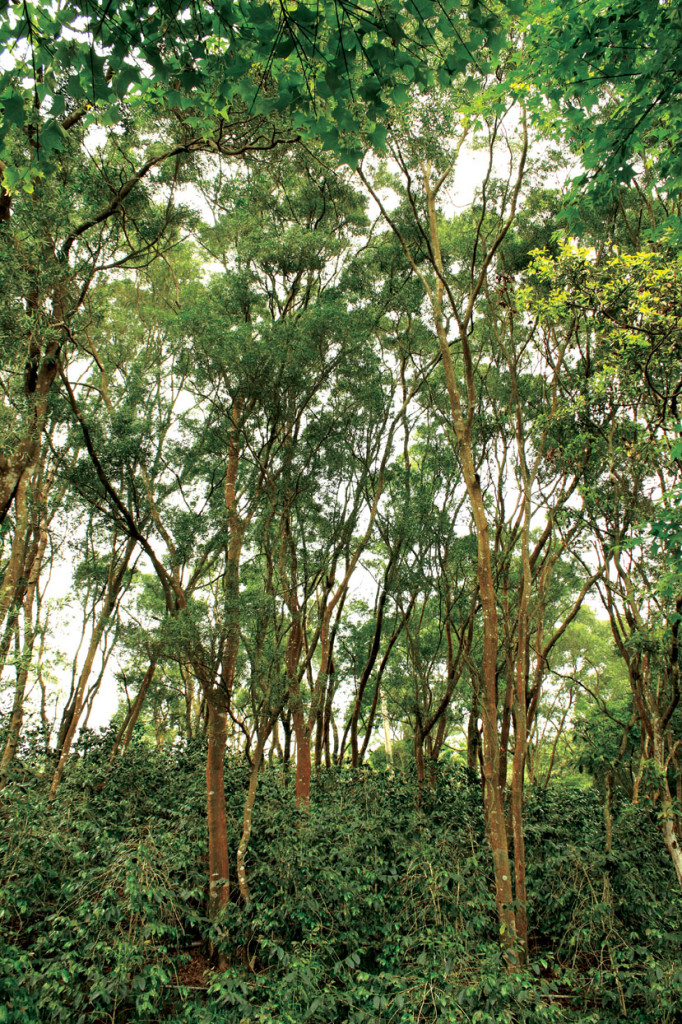
Acacia confusa used as a cover tree for coffee plantations. Acacia confusa is used in the same way for birds nest fern farms as well.
Acacia confusa Tannins
Acacia confusa, like many other Acacia species, is rich in tannins in its bark and wood. The wood and bark can be boiled in water to extract the deep brownish-red tannins. At this time, we have found no information about this species being used as a commercial tannin source, but seem to be a worthy candidate. Judging by our own clothing being permanently dyed an almost sienna brown without any kind of treatment, we are confident this would make a good candidate for tanning hides and provide other industries a steady and potentially sustainable source of tannins.
Acacia confusa Bark and Ayahuasca
Recently, as humans have experimented more, the use of Acacia confusa bark has been used as a DMT source for Ayahuasca. Ayahuasca is a hallucinogenic drink originating from South America. Traditionally, the drink contains the leaves of Psychotria species (usually P. viridis) and the stems of Banisteriopsis caapi. Psychotria species are often the plant that contains the hallucinogenic compound DMT. It is DMT that Acacia confusa, as well as numerous other plant species, provides. Typically you need at least two ingredients for an Ayahuasca brew: a DMT source and an MAOi source. An MAOi is a compound that will inhibit your body’s ability to metabolize and destroy the DMT when taken orally. Without an MAOi, DMT will be almost inactive orally due to our body’s ability to dispose of it quickly.
The most common sources for MAOi, in Ayahuasca, are Banisteriopsis caapi; a large liana from South America and the seeds of Peganum harmala from Asia. There are some considerations to take into account on health and diet when consuming an MAOi and psychedelics. Be sure to consult a source of information on the safety and medical pros and cons of said chemicals. We will not discuss the risks of Ayahuasca and individual compounds here as we feel this is more appropriately addressed by a future article more specific to ayahuasca chemistry.
As well as with ayahuasca, DMT can be extracted in its pure or near pure form and administered by vaporizing. Acacia confusa trunk and root bark contain fairly equal amounts of DMT ranging from 0.3-1.6% DMT dry weight (personal observation). Importantly, do note most extractions done with Acacia bark are not able to remove (DMT?) easily. This is said to be close to equal concentrations as DMT making the probable DMT concentration more likely in the 0.15-0.8% range (dry weight). Part two of this article will discuss more about the chemistry of Acacia confusa and also include the conclusions of some studies that are currently ongoing.
The Ethical Harvesting of Acacia confusa Trees
Ethical harvesting of bark from wild trees, not only Acacia confusa, is essential for not only sustainability but simply out of respect to the environment. Acacia confusa trees, in cultivation (in ground), may take over 10-15 years before they can start to be harvested of good quality bark. For this reason, most people tend to harvest from wild trees, as this is common with other species that are used for their bark’s DMT content. With some species such as Mimosa hostilis, only the bark from the roots is used in ayahuasca type concoctions. With many Acacia species, the root bark or more commonly the trunk bark is used. This has led to some problems with people over harvesting less abundant Acacia species in other countries.
Acacia confusa root bark and trunk bark (from mature stems) are virtually the same in DMT concentrations (pers. comm., personal observation). Trunk bark is infinitely better on the ecosystem and we encourage the readers to avoid using root bark unless they know for sure the root bark was sustainably harvested. What does sustainably harvested actually mean? Well, to us it means the harvesting of bark without causing detriment to the tree or ecosystem. How is this accomplished? By picking and choosing trees carefully that have recently fallen, or going somewhere where someone is cutting them down anyway. In this way you are not harming healthy trees or habitats specifically to harvest the bark. In a place like Taiwan, with such steep mountains and extreme weather, there are many trees to choose from without ever thinking of killing a healthy standing tree. When walking through the dry mountainous forests that are dominated by Acacia confusa, one can easily find fallen trees. Due to Taiwan’s typhoon season every summer, there are not only high winds, but very heavy rainfall which ensures there will be a fresh supply of fallen trees every year, without fail. As a result of hiking through the mountains, I have estimated that for every 70 to 100 trees, there is one recently fallen tree ready to hardy. This estimate is in winter; however, there are a lot more just after the summer typhoon season.
Older trees that have been dead for a while are not suitable for use. This is due to dead cells that are riddled with fungi mycelium and perhaps also insects. Once the tree truly dies, the tree will first shed leaves then the bark dehydrates and becomes very hard. It is easy to tell because the bark will be a darker brown instead of a red-pink colour under the surface. Furthermore, the bark will break rather than bend, making it very inconvenient to harvest. Fresh Acacia confusa bark from a living tree is fairly flexible.
Dead trees, even some live trees, are magnets for fungi. Once the fungi takes hold, the tree is often invaded by beetle larvae, termites and ants soon after. Ganoderma multipileum (Wang, D. M. et al, 2009) is particularly fond of this species and good reishi mushrooms can sometimes be found while out on a hike through Acacia trees. After years of consuming Ganoderma species from Acacia confusa, it seems as if there is no DMT transferred into the mushroom from the tree; though, we are not aware of any such formal investigation.
When fallen trees are found, most likely they have blown over and the roots have been pulled up at least at one side. Acacia confusa rarely snap in high winds. The trees have evolved to withstand incredibly high wind speeds and the trunks are solid as a result. With trees that have blown over and presented exposed roots, we now have access to root bark as well as trunk bark from the same tree. In this manner, one can still sustainably harvest root bark from the tree without disturbing the ground further. Standing trees with exposed roots growing down the mountainside should not be harvested as they will likely be killed in the process and in time will lead to further soil erosion.
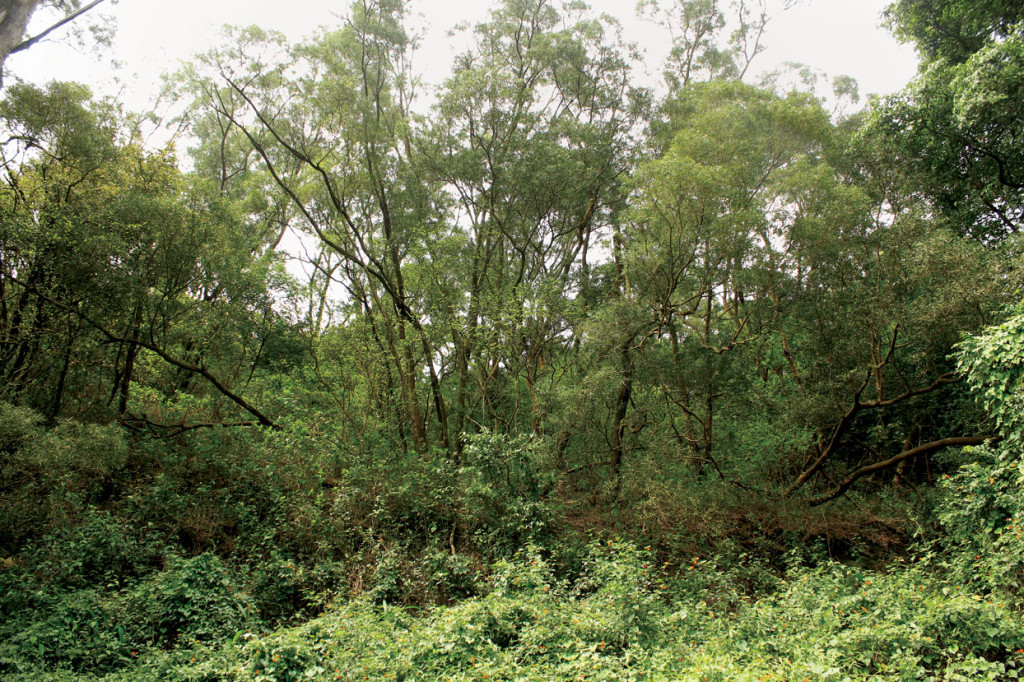
Acacia trees in forest that have recently fallen due to high winds. With 7 large trunks in this one spot, over 50kg of dry high grade bark was harvested.
Harvesting Acacia confusa Root Bark
We strongly discourage harvesting root bark unless the trees are already cultivated, fallen, or the roots have been exposed. One should not harvest the roots from healthy trees that have roots exposed. Due to the commonly steep mountains sides in Taiwan and Acacia’s ability to cover said mountains, there are usually some good sized roots exposed at the surface before reaching down into the rock for an anchor. These trees are essential for protecting the mountains against erosion. Stripping them of bark will not only expose them to the sun which may dry out the root, but also invite fungi spores to germinate and start eating the trees roots. A cleared mountain side in Taiwan can be bare rock after one rainy season. This is due from the fact heavy rain washes away the soil and smaller weaker plants; thus, having trees with good roots is of huge importance to the ecosystem.
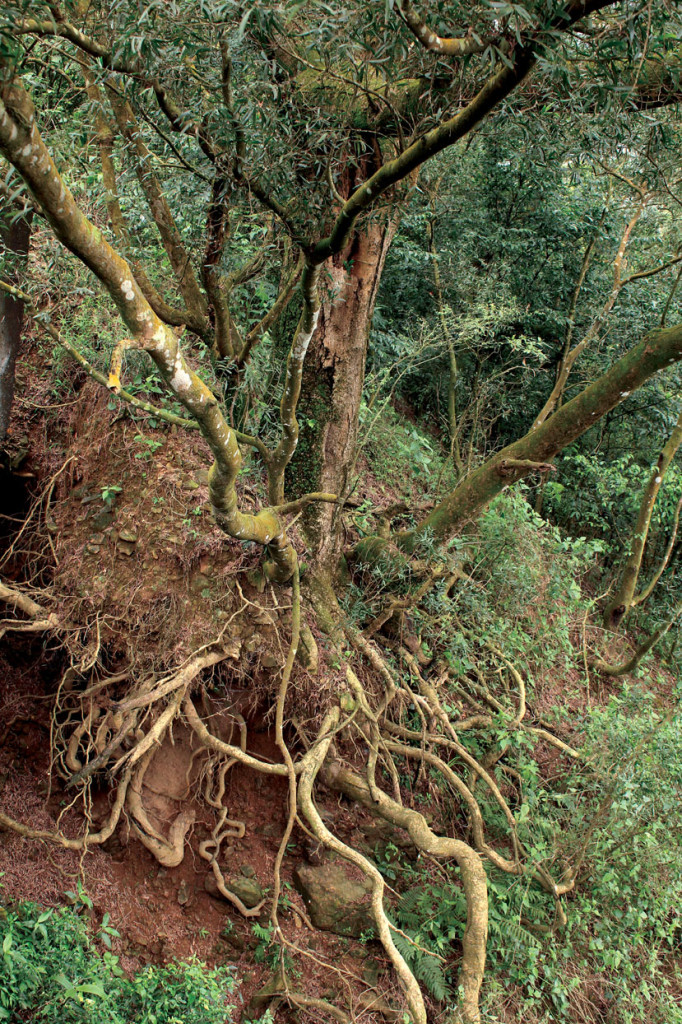
Trees like these with exposed roots may seem ideal, but harvesting such plants will kill the roots and destroy the single biggest thing holding up the dirt that has taken thousands of years to form.
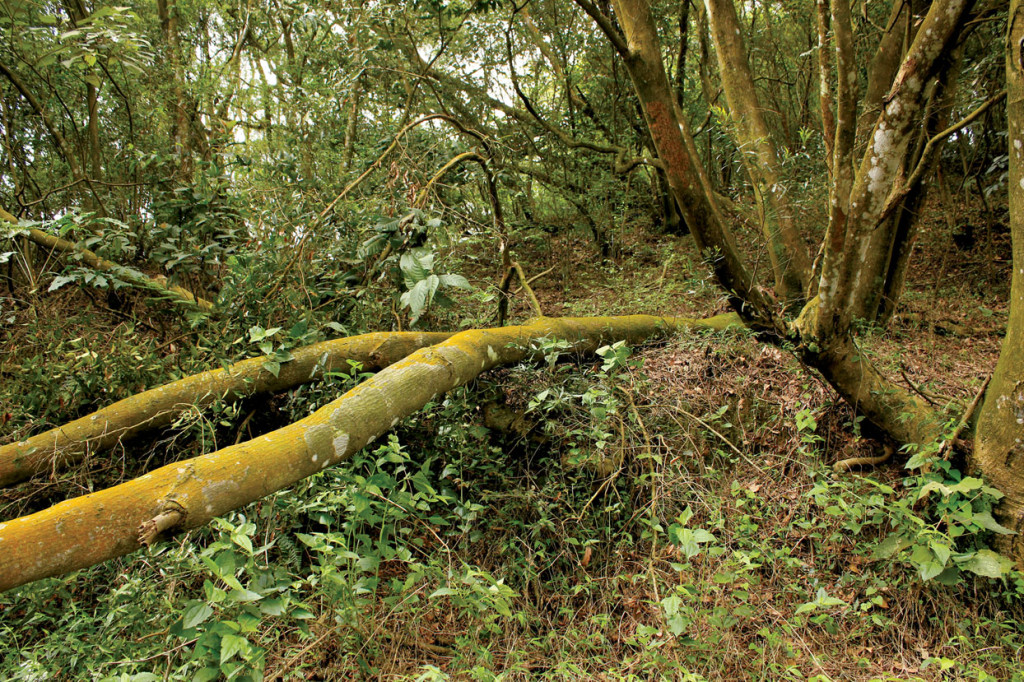
Trees such as this are ideal for harvesting as they have fallen naturally, the bark is fresh and it is very easy to access.
Once a suitable tree has been selected, and has made sure the impact to the surrounding environment is minimal, one can start cleaning away the rock and dirt from the roots. More importantly, care should be taken not to dig out large areas of dirt, as this will also cause landslides in future rains. We find that roots of about 10cm in diameter or larger are best to use. Smaller roots tend to have thin pale bark and may not yield as strong a product in the end. However, it is all good, so if it is available, use it. More info will be published in part two of this article on DMT concentrations in different bark.
The root bark will be covered in dirt. Wash the root bark onsite if there is a water source nearby to make the process easier. Avoid washing bark once stripped. You will no doubt be washing away some of the compounds you are there to collect; albeit small amounts. Once washed, use a machete or similar strong blade to cut the circumference of the bark and make one more gash lengthwise. Under the corner of the cut, push in the tip of the blade between the bark and the wood and lift up; taking care not to snap the blade. Once the bark is pried up enough, the bark can be pulled up by hand. Good bark will be a pink-red color, ranging from a light-medium pink to a darker reddish-pink. If the bark is getting white-yellow, avoid harvesting from such a young section of root.
Harvesting Stem Bark
Stem bark is preferred over root bark for two reasons. Stem bark is far easier to harvest from the tree and prepare at home. First, about half or more of your time is freed up simply by not digging and washing roots prior to harvest. Second, you are also not actively encouraging soil erosion by digging in the ground, disrupting and killing important root and mycelium systems that are helping to hold the mountainside together. For these two reasons and because the end product is of like quality, we see little reason to perpetuate the habit of root bark harvesting that began with Mimosa hostilis harvesting. Unlike Mimosa hostilis, Acacia confusa has large amounts DMT in the stem bark. Thus, the stem bark can be harvested following a different set of guidelines than Mimosa hostilis which only has high concentrations of DMT in the root bark.
Trunks that are 30cm or more in diameter are the best to harvest from. This is because they are large in physical size, although still variable, and always contain high concentrations of DMT. Smaller stems can be used just the same. Do not waste the smaller stems because they still contain a varying amount of DMT that is certainly worth taking home. In ayahuasca brews, smaller branch bark (5-15cm diameter) seemed noticeably weaker than good thick old bark taken from larger trunks. At this time, it seems to be that the thicker, more resinous dark bark is stronger. The chemistry of Acacia confusa will be reported on in a future article in greater detail comparing such materials against each other.
As with harvesting the root bark, two cuts are made on the trunk in a cross figure. With sustainable harvesting practices, the trees will have fallen already and will often be more or less horizontal. This makes a day in the woods much more pleasant; unless the trunks are hanging over a cliff. With a cross shaped cut, slide the blade under a corner of bark and pry it up about 5-10cm. We find it more convenient to cut another cut crossing the grain lower down about 1 meter. This makes the cutting easier down the trunk and when the bark is pulled it will not tear into many small strands but instead rip off into solid strips. This is especially important if you are transporting the trunks in a backpack out of the mountains as it will pack tighter into your pack. As a general guideline, one can fit about 70KG of bark into a 90 litre backpack. However, at that weight, more is not usually considered.
Effects of Harvesting Acacia confusa on the Environment
Harvesting living standing Acacia confusa trees has some very serious and sometimes irreversible effects on the environment. The biggest problem with harvesting is the obvious risk to the tree. Harvesting all the way around a trunk will most certainly kill the entire tree. The wood of the tree is generally composed of many dead cells which give the tree its structure and strength (aka wood). Furthermore, all the transport cells that take nutrients and water to and from the roots and the shoots are between the outer bark and the wood beneath. If the bark must be harvested from standing trees, we suggest taking no more than 10% of the circumference. Although this will still harm the tree and open it up to infection and pests, taking less is far better method than stripping the entire tree. One does not need a lot of bark; a single 10cm by 200cm piece is enough bark for approximately 20 people. We strongly urge people, however, to put in more effort and avoid being greedy and/or lazy in order to quickly reap the rewards of the environments’ destruction.
When whole trunks are harvested, the tree and roots die within 1-3 years. The trees become brittle and riddled with fungi and bugs begin feeding on them. Further, they lose the ability to hold up the mountainside and soil erosion may be the result. Soil erosion is a global problem, and more often than not the end result is a barren land that is incredibly difficult and slow to regenerate to its former glory.
For now Acacia confusa is not an endangered tree, and is in fact quite a common tree throughout lower elevations in Taiwan. There are growing concerns in places such as extreme southern Taiwan where invasive species. For example, Leucaena leucocephala is out competing Acacia and other native species (Chieh-Chin, Chin 2007). Although at present, there seems little risk of endangerment of Acacia confusa, we should be careful where harvesting as to not disturb the ground so much that only invasive species may thrive.
Traditional use in Taiwan
Traditional use of Acacia confusa seems to have more to do with simple building material and firewood in Taiwan. Although Acacia confusa is used a little bit in Chinese Medicine, this medicine style is brought over from mainland China and is perhaps technically not traditional for Taiwan prior to Chinese occupation.
Many aboriginal tribes in Taiwan are hunter/farmer type societies. Animals make up a huge part of the diet. Furthermore, different tribes tend to stay in one area for long periods building homes and making hunting trips into the mountains. Where we often hike in Pingtung County, the aboriginal people make houses out of the shale like rock and stack the rock much like bricks. Roofs are made of wood poles underneath, often bamboo, with larger slates of rock on top acting as shingles for the rain.
It is rumoured that some older aboriginal people know of the power of the Acacia tree. However, there is little proof of such and members of various villages we have talked with either were not aware of the use or were not willing to share their knowledge on the species in relation to its psychoactivity.
Importantly, do note that this is simply an observation and more of a curiosity than a point; many of the aboriginal towns in the mountains do cultivate entheogens. Of particular commonality is a Brugmansia hybrid (a newer introduction to Taiwan and a hybrid we have not yet seen in use by aboriginals but have seen used in Chinese Medicine in Taiwan), Nicotiana tobacum and alcohol production. This is only mentioned because it seems possible some aboriginal people are aware of psychoactive plants. Therefore, it seems at least plausible that some of the native people in Taiwan are aware of the secret Acacia confusa holds. At one time, a man stopped us from picking the flowers of a large stand of Brugmansia trees growing in a riverbed near where we camped. He noticed a large bag filled with flowers and was warning us. The man could not speak English of course or Mandarin, but was clearly trying to warn us not to eat them. Pointing to his mouth in a typical eating motion, the man pointed to his temple and twisted his fingers. In Taiwan this means crazy. It is an interesting topic, not given much of a look unfortunately. However, the flowers could have been simply ornamentals and they were unaware. Nevertheless, we wanted to have this note here in print to perhaps spark an interest for further study.
Acacias’ Role as a Home Tree
Acacia confusa is home to a number of organisms such as bark scorpions (Liocheles australasiae), numerous spiders and insects, and smaller plant species (personal observation). Birds also nest in Acacia trees, which brings in predators such as snakes and civets. Macaques will also play around in the trees, although they have no food source from an Acacia tree so they tend not to stick around long in a predominantly Acacia forest. Geckos, skinks, japaluras, birds, beetles, termites, ants, butterflies, fungi and mammals all use this tree in one way or another. Most permanent residents to an Acacia confusa tree are generally small in size as the tree provides food for very few organisms.
Larger trees that are thick and have many nooks and crannies will serve home to far more animals. However, when older, the tree will serve as a host to fungi and plant life as well. Large trees sometimes have ferns growing in the crotch of a branch emerging from the trunk. The larger trees also tend to have thick bark at the joins (joints?), which often pops up off the inner wood and serves home to a plethora of organisms. Many fungi species live off the dead wood of this tree, but even live trees can be affected by Ganoderma multipileum, a reishi mushroom species often confused with G. lucidum from Europe (Wang, D. M. et al, 2009).
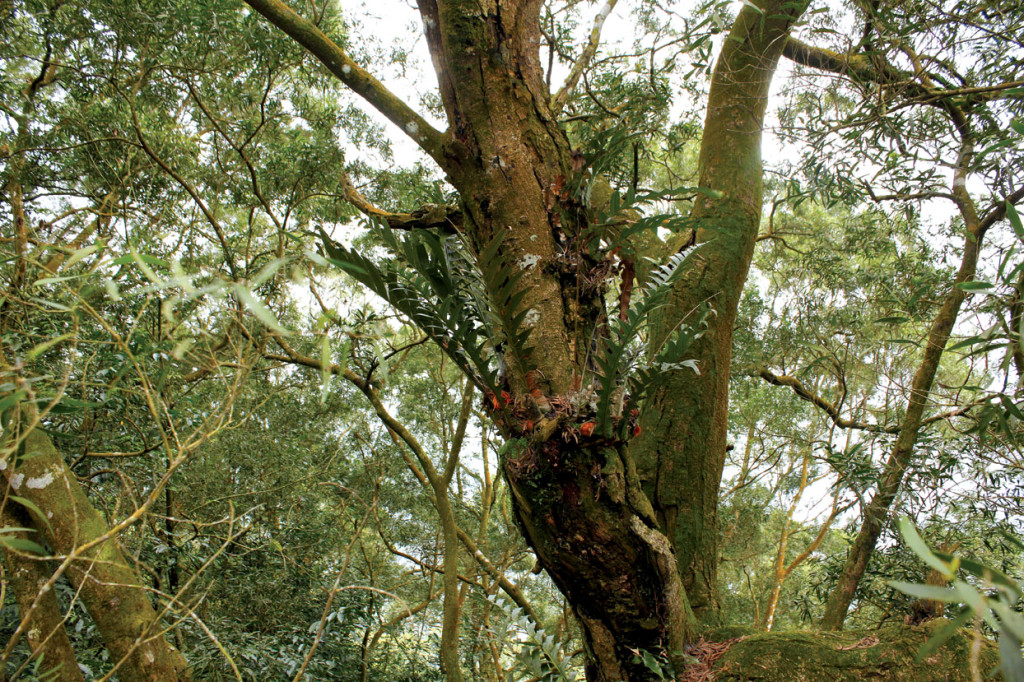
This Acacia confusa tree is very old, likely over 100 years, and is about 100cm in diameter. Large trees like this are often host to many small animals and plants such as these ferns. Orchids, vines and epiphytes often use large trees like these for support.
Although Acacia confusa is used by many organisms for a home tree, few organisms feed off it. Fungi are probably the biggest nuisance to an Acacia confusa tree in Taiwan. The phyllodes are sometimes nibbled by the odd insect. About the only part of the tree that regularly fed upon by an animal is the seed. Insect larvae of various species, especially beetles, like to chew through the seed pod and eat the seeds inside where they eventually pupate to adult form. This behaviour is not just limited to Acacia confusa, but in fact the fruits of many species within the Fabaceae family are quite attractive to bugs of this sort.
Conclusion
Acacia confusa has proven worthy as an ayahuasca source plant as it is quite common, contains high concentrations of DMT, is able to be sustainably harvested with little impact to the ecosystem and is easy to work with. Taiwan alone has millions of trees and by my own estimates over 50,000 trees fall over each year that can be easily accessed by people. Acacia confusa is a very promising tree species not only for commercial prospects but for medicinal properties and valuable role in the central mountains of an island nation once known as Formosa.
BIBLIOGRAPHY
Flora of Taiwan 2nd Edition(1993). 1. Acacia Willd. Pages 161-163 Available free at: http://tai2.ntu.edu.tw/ebook.php
Hsieh, C. F. (2002) Composition, endemism and phytogeographical affinities of the Taiwan Flora. Taiwania 47(4): 298-310. Available free at: http://tai2.ntu.edu.tw/taiwania/
Wang, D. M., Wu, S. H., Su, C. H., Peng, J. T., Shih, Y. H. and Chen, L. C. (2009). Ganoderma multipileum, the correct name for “G. lucidum” in tropical Asia. Botanical Studies 50: 451-458. Available free at: http://ejournal.sinica.edu.tw/bbas/
Chieh-Chih Chin, Chun-Hung Wei, Chaur-Tzuhn Chen (2007). Study on the Invasion of Leucaena leucocephala in Kenting National Park. Hwa Kang Journal of Agriculture No. 20 Pages 41-51. http://www.airiti.com/teps/ec_en/default.aspx
Additional Reading
Yeh Ching-Long (2003). Studies on the Diversity along the Sere of Acacia confusa Plantation in Nanjenshan Area. Proceeding of the Symposium of Vegetation Diversity in Taiwan Dec 04 2003.
Herbarium specimen scans at NTU. http://tai2.ntu.edu.tw/Specimen/species-specimen.php?folderID=409%20002%2007%200&display=pic
Reforestation By Tree Species Available at:
http://www.forest.gov.tw/public/Data/182416535771.pdf
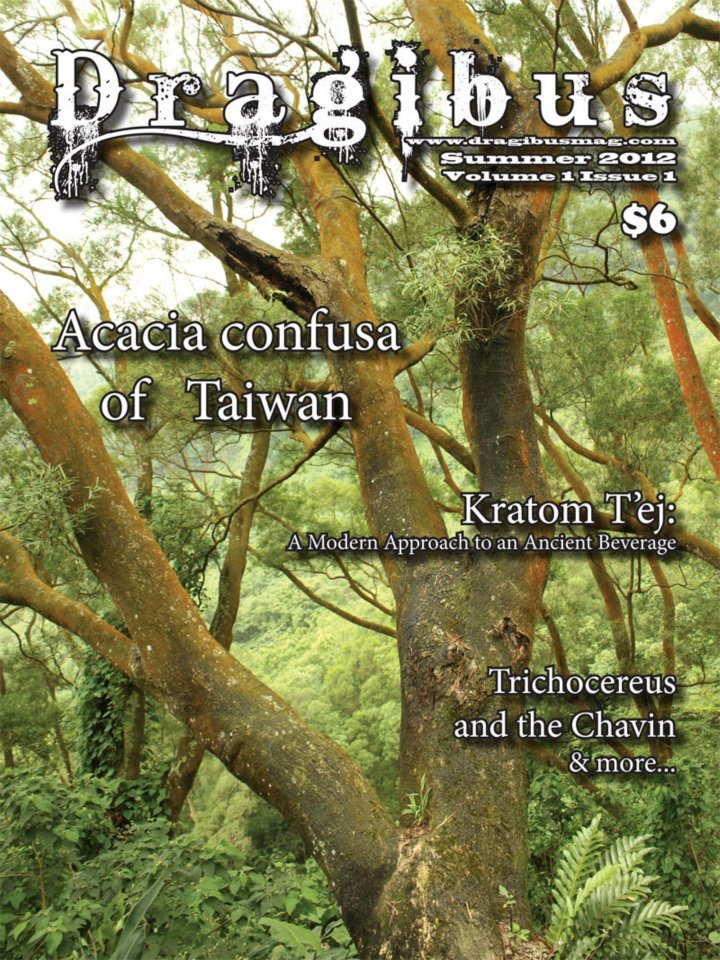 Order a copy of this issue:
Order a copy of this issue:
International ($11.50):


